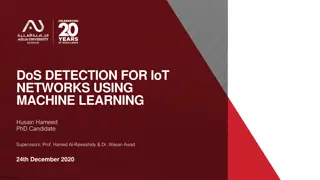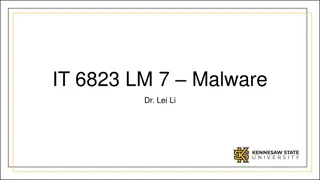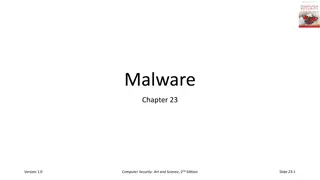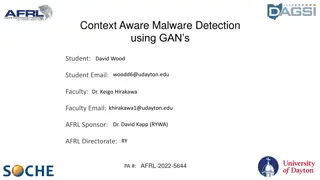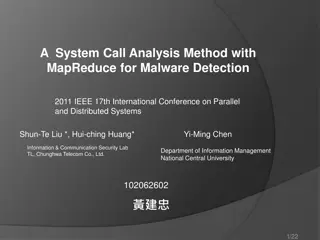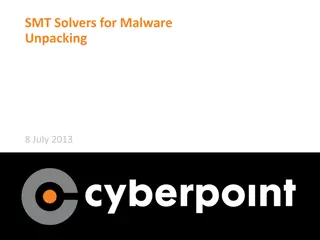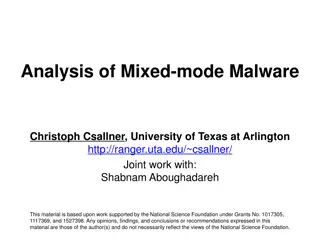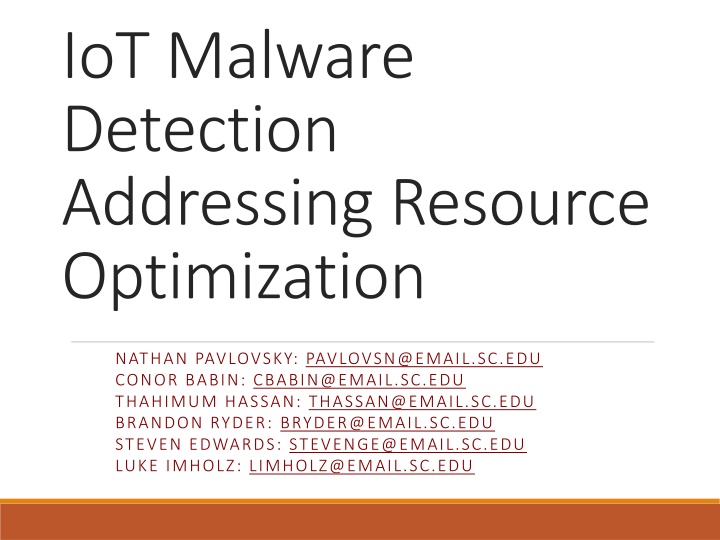
Optimizing IoT Malware Detection for Resource-Constrained Devices
Addressing the challenges of IoT malware detection on devices with limited memory and processing power. Solutions include using a one-time classifier, overcoming internet connectivity issues, handling heterogeneous OSes, and optimizing resource allocation. The goal is to develop a robust and scalable product while maintaining high detection accuracy.
Uploaded on | 1 Views
Download Presentation

Please find below an Image/Link to download the presentation.
The content on the website is provided AS IS for your information and personal use only. It may not be sold, licensed, or shared on other websites without obtaining consent from the author. If you encounter any issues during the download, it is possible that the publisher has removed the file from their server.
You are allowed to download the files provided on this website for personal or commercial use, subject to the condition that they are used lawfully. All files are the property of their respective owners.
The content on the website is provided AS IS for your information and personal use only. It may not be sold, licensed, or shared on other websites without obtaining consent from the author.
E N D
Presentation Transcript
IoT Malware Detection Addressing Resource Optimization NATHAN PAVLOVSKY: PAVLOVSN@EMAIL.SC.EDU CONOR BABIN: CBABIN@EMAIL.SC.EDU THAHIMUM HASSAN: THASSAN@EMAIL.SC.EDU BRANDON RYDER: BRYDER@EMAIL.SC.EDU STEVEN EDWARDS: STEVENGE@EMAIL.SC.EDU LUKE IMHOLZ: LIMHOLZ@EMAIL.SC.EDU
Addressing the problem IoT devices have limited memory and power, making balancing malware detection algorithms efficiency, accuracy, and resource usage a significant issue.
Challenging Aspect: Internet Connectivity Challenging Aspect: Internet Connectivity One Time Classifier Resolved by using a one-time classifier that only needs to update when server connectivity is available We propose a CNN neural network classifier; is trained on binaries that are converted to gray-scale images Overcoming Connectivity Issues Malware detection systems that require internet connectivity faces the issue of failure without internet. This impedes the usage of a centralized cloud-based algorithm for continuous detection process.
Challenging Aspect: Heterogeneous OSes Challenging Aspect: Heterogeneous OSes Security Interpreter (SECI) Creates a lightweight virtual environment on machines Limited architecture Little memory & power used For most important OSes Problem: large fragmentation of the IoT market among different operating systems and hardware configurations
Challenging Aspect: Limited Memory and Processing Power Main training of classifier is offloaded to the server. Limited computational resources restricts IoT devices from using resources for the purpose of malware detection. Harnessing GPU processing power and parallelization techniques will help power classifier execution on end hosts
Conclusion and Future Work Conclusion and Future Work It is estimated that this approach can result in an affordable, robust, scalable, and commercially-viable product for market deployment in two years. Further work can be done to determine if it is sufficient to train one overall malware-detection model or if multiple models for different malware families need to be trained. GOAL: maintain at least 95% detection accuracy

